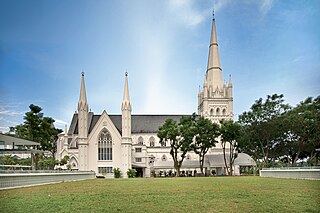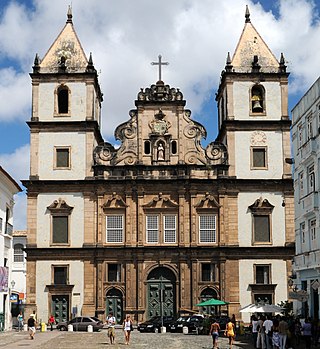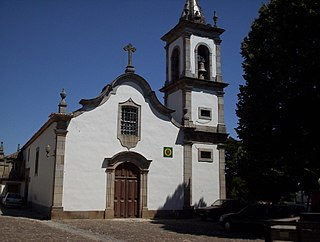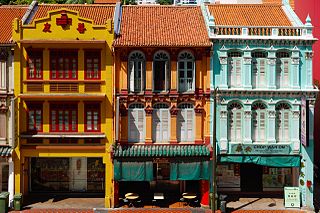Related Research Articles

The Urban Redevelopment Authority (URA) is the national urban planning authority of Singapore, and a statutory board under the Ministry of National Development of the Government of Singapore.

Saint Andrew's Cathedral is an Anglican cathedral in Singapore. It is located near City Hall, Downtown Core, within the Central Area in Singapore's central business district. It is the cathedral church of the Anglican Diocese of Singapore and serves as the mother church to 27 parishes and more than 55 congregations. The church has existed on the site since 1836, although the current building was constructed in 1856–1861. The logo of the cathedral is the St Andrew's Cross.
The Cathedral of the Good Shepherd is the oldest Catholic church in Singapore, built in 1847. It is located in the Museum Planning Area within the Civic District.

Boat Quay is a historical quay in Singapore which is situated upstream from the mouth of the Singapore River on its southern bank. It spans from the shophouses near UOB Plaza, stretching along one bank of the Singapore River, all the way till Elgin Bridge.

Azulejo is a form of Portuguese and Spanish painted tin-glazed ceramic tilework. Azulejos are found on the interior and exterior of churches, palaces, ordinary houses, schools, and nowadays, restaurants, bars and even railways or subway stations. They are an ornamental art form, but also had a specific functional capacity like temperature control in homes.

The Cathay Building was opened in 1939 by Dato Loke Wan Tho as the headquarters for the British Malaya Broadcasting Corporation. Located at 2 Handy Road in the Museum Planning Area of Singapore, the building was most known for its air-conditioned theatre known as the Cathay Cinema, then a technological marvel and the first to be built in Singapore. Cathay Building was the first skyscraper in Singapore and tallest building in Southeast Asia at that time. It was demolished in 2003.

Saint Joseph's Church is a Roman Catholic church in Singapore. It is located along Victoria Street in the Rochor Planning Area, within the Central Area of Singapore's central business district. The church was constructed from 1906 to 1912 with its foundation stone laid in 1904. The building was built in the Neo-Manueline Portuguese late-Gothic style by the Portuguese Mission. Saint Joseph's Church is noted for its Portuguese-inspired religious traditions, such as the annual Good Friday celebrations.

CHIJMES is a historic building complex in Singapore, which began life as a Catholic convent known as the Convent of the Holy Infant Jesus (CHIJ). The complex is located at Victoria Street in the Downtown Core, within the Central Area, Singapore's central business district.

Holy Family Academy, also referred to by its acronym HFA, is a private Catholic basic education school administered by the Congregation of the Missionary Benedictine Sisters of Tutzing in Angeles, Pampanga, Philippines. It was established in 1906 as a Catholic parochial school and named Colegio de la Sagrada Familia in 1910. It is now one of the most prestigious schools in Angeles City. It has both elementary and high school departments as well as kindergarten and preparatory school classes for younger students. The school follows the Benedictine tradition of Ora et Labora, which means "Prayer and Work".

The São Francisco Church and Convent of Salvador is located in the historical centre of Salvador, in the State of Bahia, Brazil. The ornate Church of the Third Order of Saint Francis sits adjacent to the convent. The friars of the Franciscan Order arrived in Salvador in 1587 and constructed a convent and church on the site. This structure was destroyed by the Dutch during the Dutch invasions of Bahia in the next century; Father Vicente das Chagas initiated the current structure in 1686, which was completed in the 18th century. The Franciscan church and convent have the largest number of azulejos, 55,000, of any church in Latin America.

The Igreja de Santo Ildefonso is an eighteenth-century church in Porto, Portugal. The church is located near Batalha Square.

Carlton Hill is an inner-city area of Brighton, part of the English city and seaside resort of Brighton and Hove. First developed in the early and mid-19th century on steeply sloping farmland east of central Brighton, it grew rapidly as the town became a fashionable, high-class destination. Carlton Hill's population was always poor, though, and by the early 20th century the area was Brighton's worst slum: overcrowding, crime and disease were rife. Extensive slum clearance in the mid-20th century introduced high-density tower blocks, but some old buildings remain: in 2008, Brighton and Hove City Council designated part of Carlton Hill as the city's 34th conservation area. The area now has housing of various styles and ages, large offices and small-scale industry; there are also churches, a school and some open space.

The Palace of the Counts of Azambuja, alternately the Palace Valada-Azambuja is a 16th-century Portuguese estate manorhouse/palace situated in the civil parish of Misericórdia, municipality of Lisbon.

The Museu Nacional do Azulejo, occasionally known in English as the National Tile Museum, is an art museum in Lisbon, Portugal dedicated to the azulejo, traditional tilework of Portugal and the former Portuguese Empire, as well as of other Iberophone cultures. Housed in the former Madre de Deus Convent, the museum's collection is one of the largest of ceramics in the world.

The Church of St George is a Roman Catholic church in Taunton, Somerset, which dates from the mid-19th century. It was the second Catholic church to be built in Taunton after the Reformation, replacing the much smaller St George's Chapel. The main church building is designated by Historic England as a Grade II* listed building, while the rectory is Grade II listed.

Courtenay Gate is a block of serviced apartments on the seafront in Hove, part of the English coastal city of Brighton and Hove. Situated in a prominent position next to the beach and overlooking Hove Lawns, the six-storey block is Neo-Georgian in style and dates from 1934. It is in a conservation area and is a locally listed building. Built to replace a terrace of early-19th-century houses which had been demolished more than 30 years earlier, the "imposing" gault brick building has a "palatial" appearance and is a landmark on the seafront.

The Church of São Luís is a Latin Catholic Baroque church and former cathedral in the civil parish of Pinhel, in the municipality of the same name, Portuguese district of Guarda.

The Convent of Santo António da Cidade is a former-convent and public library in the civil parish of Bonfim, in the municipality of Porto, in the Portuguese district of the same name.

Sino-Portuguese architecture, also known as Chinese Baroque,Straits/Singapore Eclectic architecture or Peranakan architecture is an Asian hybrid style incorporating elements of both Chinese and Portuguese architectural styles. It is common in urban centers where Chinese settlers lived in southern China and the Peranakans of the Malay Peninsula, with examples found and most prominently conserved and maintained in Singapore.

The Chek Jawa Visitor Centre, also known as House No. 1, is a visitor centre and former holiday home on Pulau Ubin, Singapore. It is believed to be the last remaining authentic Tudor-style building in the country.
References
- ↑ Teng, Amelia (1 July 2016). "104-year-old Parochial House of St Joseph's Church to be gazetted for conservation". The Straits Times . Singapore. Retrieved 25 May 2024.
- 1 2 3 4 "St Joseph's Church Parochial House reopens after 7-year restoration". CatholicNews . Singapore. 3 April 2024. Retrieved 25 May 2024.
- 1 2 3 "PAROCHIAL HOUSE OF ST JOSEPH'S CHURCH". ura.gov.sg. Urban Redevelopment Authority. 30 June 2016. Retrieved 11 April 2024.
- ↑ "St Joseph's Church parochial house gazetted". CatholicNews . Singapore. 24 July 2016. Retrieved 25 May 2024.
- ↑ "104-YEAR-OLD church building marked for conservation". TODAY . Singapore. 1 July 2016. Retrieved 25 May 2024.